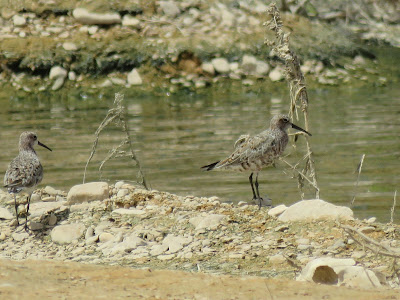As I walked towards the little lake there was a heck of a lot of noise overhead with a Little Ringed Plover screeching overhead. Then another as I walked along, soon I came across this bird with what appeared to be an injured wing.
It shot up and down on the tiny island in the middle of a small pool, flapping about and dragging its wing alongside. Classic Plover defence behaviour. I did not see where the eggs were and took the opportunity to follow the parent away from the site. But I think its fairly clear there are breeding Little Ringed Plovers in the area.
In the lake itself there were Coot and Moorhen both with young fledglings in tow. This Moorhen chick must have been feeling a bit brave or suicidal, there are a lot of Herons and White Throat Kingfishers etc. about who have been known to like a bit of baby bird.
Speaking of White Throated Kingfishers, apologies for the poor photos but these were a long way off. Here are three together which I thought was odd. You often see them in pairs but three is a little strange. As I focused in it appeared that one (the dot on the right) was duller and browner than the others and I think is a Juvenile.
Moments later one moved up to the hole which I now believe is their nest. Looking up my bird books I note that Helm does not show these at all in the area, clearly wrong as I see them every week. However, most of the others show them as occasional sightings and Mike Jennings (Atlas of Breeding Birds of Arabia) has them as probable breeders in the area. Hopefully these photos will go some way to proving they are breeding here. Anyhow I doubt anyone who birds around the area regularly would doubt for a moment that they breed here. There are at least 3 pairs I know of around Al Hayer fields and several further up towards the Al Hayer village bridge. More anon.
Just a little shot of some Coots and young
Also breeding on the lake are a couple of pair of Black Winged Stilts and if you want to know where the partner was the answer is dive bombing me!! No I was not very close at all, but I guess he did not like me on the same planet at that point.
A second sitting bird.Ok this one you'll have to take on trust. This photo I got of one of the parents but below it in the reeds was the other parent and a recently fledged young bird. Unfortunately reeds and autofocus on bridge cameras don't mix very well.
The last two photos are one of the colonies of Streaked Weavers that are all around the reed beds here. I think these two females are busy checking out the males efforts, if she like she may move in!
Meanwhile one of the males puts some finishing touches to his creation.
A very interesting trip and delightful to see my local patch is such a hive of breeding activity. There are a couple more I am keeping my eye on at the moment, but I won't say more until I get some sort of proof.
© Bernard Bracken































































